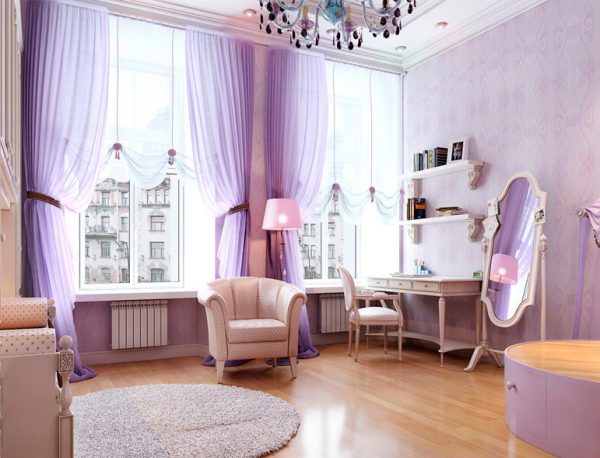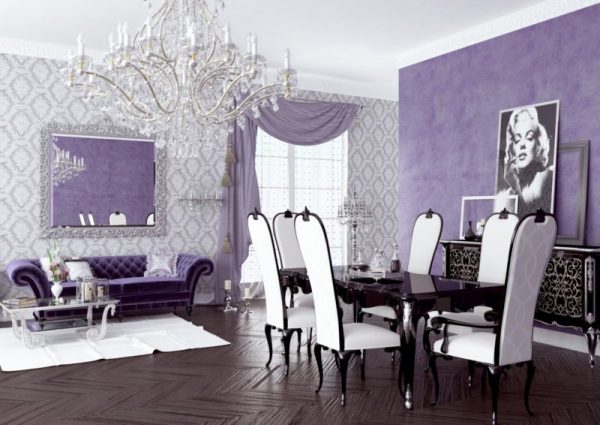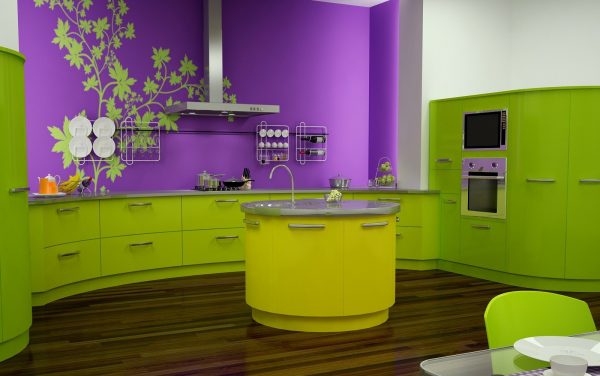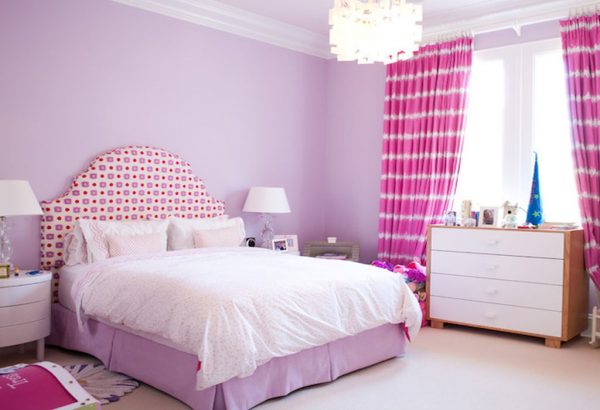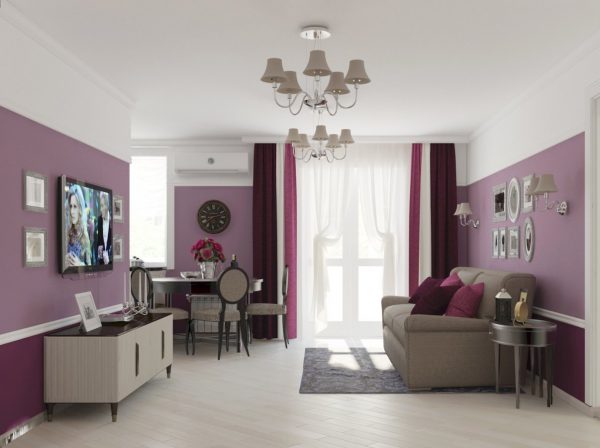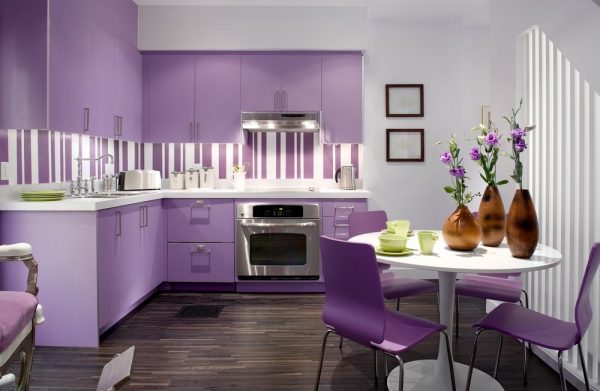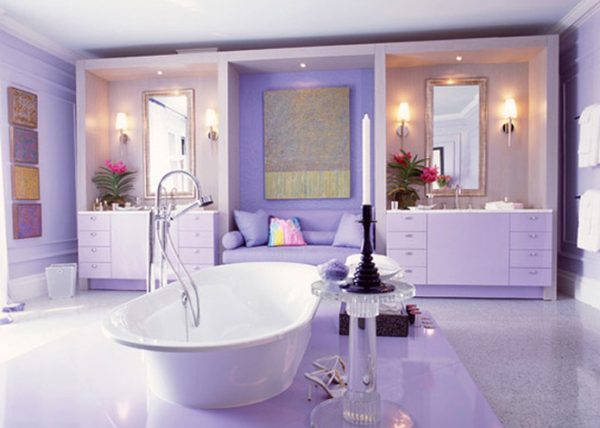Lilac shade is included in the palette of purple flowers. It is also formed by the combination of blue and red paint, only lighter, which is achieved by adding a white tone. The presence of white gives the shade of lilac a touch of sophistication and femininity. Lilac color in the interior allows you to create unique and very delicate combinations, it is only important to choose its combination with other shades.
- Features of color and influence on the psyche
- Lilac Shades
- Combinations with other colors.
- Lilac with white
- Lilac with gray
- Lilac with green
- Lilac with yellow
- Lilac with beige
- Violet-lilac interior
- Pink lilac design
- The combination of lilac in different rooms
- Living room
- Bedroom
- Kitchen
- Children's room
- Bathroom
- Hallway
- Lilac color in different interior styles
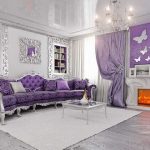
Features of color and influence on the psyche
Lilac means bleached violet, it belongs to the cold spectrum of tones and is well suited for rooms whose windows face east and south. Adding more red paint leads to a "warming" of the shade, so it can be used even in northern rooms.
The gentle lilac color harmoniously fits into many interior styles: it is relevant both in the classics, in the modern, and in vintage directions. Hue brings its charm to any room, giving a person a powerful energy charge. In psychology, lilac is important: it symbolizes sensuality, mystery, creativity and romanticism.
Color has a positive effect on a person: if applied within reasonable limits, it will help to calm down, get rid of unnecessary anxieties, and reduce the effects of hyperactivity. At the same time, with excess, lilac can provoke fear, depression, because it is formed by two strong and rather aggressive tones that are opposite to each other. It is also believed that a too bright lilac palette can cause distrust and secrecy in communication.
to contents ↑Lilac Shades
In nature, shades of lilac in a pure form are not common - mainly in the flower petals of lilacs and some other plants. But even more than forty varieties of lilacs, and artificially created lilac tones are much more. According to the shade tables, designers determine the tone suitable in a particular situation, and then select companion colors for it.
The most popular colors in interior design are:
- classic lilac;
- gray-lilac;
- soft purple;
- pale violet;
- bluish-lilac;
- pale lilac;
- lavender;
- blue-lilac;
- blurry purple;
- beige and lilac;
- lilac mother of pearl;
- cyclamen;
- silver lilac;
- amethyst etc.
to contents ↑All differences in tones are due to the proportion of blue and red, as well as the amount of white and the presence of additives of other colors. For example, the pastel white-lilac color contains a lot of white, and blue-lilac is easier to call blue with a lilac shimmer: it is so dark. There is a lot of pink in violet color, dusty lilac has a muffled, smeared tone, therefore it is very popular in design.
Combinations with other colors.
Lilacs can be combined with various shades.It is not recommended to use this tone to create a monochrome interior; it looks better surrounded by contrasting tones.
Lilac with white
Shades of lilac are perfectly combined with white - the freshest, neutral color. Ready duet will look gentle, romantic. The warm range of lilac shades goes well with cream, milk tones, and cool colors (with more blue than red) are ideal for crystal-white tones. If light lilac shades are the background for the walls, then white can be used in the form of ceiling colors and various accents - paintings, figurines, textiles.
to contents ↑Lilac with gray
This combination is considered very stylish, but rather cold. Gray color is better to use as a background that sets off lilac details, while making the interior more complex and multifaceted. Such a gamut looks great with a laminate floor, parquet with a gray tint (for example, smoky oak), as well as with granite or grayish marble.
to contents ↑Not bad lilac is combined with shades of metal, especially with silver. Silver-colored curtains will give the room an elegant, glamorous look, and white furniture on a lilac background will complete the stylish image of the room.
Lilac with green
Green in tandem with lilacs is considered a classic option for interior design in Provence style. This gamut suggests the idea of flowering plants: lavender, irises, lilacs, violets. It is only important to choose the right shades. A green-brown or olive color with lavender looks beautiful, and turquoise - with dark lilac with a dilution of beige, white tones. A palette of pistachios or mint is suitable for pastel, whitened varieties of lilacs. One or two tones should be made dense, while be sure to supplement them with blurry details.
to contents ↑Lilac with yellow
Yellow paired with lilac is a fashionable design option for interior decoration. In some color combinations, the sunny color is lost, but here it opens up in full force, gives a positive energy. It is best to combine pink-lilac tones with mustard yellow (warm gamut) or bluish-lilac tones with lemon (cold palette).
Lilac with beige
Milk and cream, beige, caramel gamma is perfectly combined with lilac flowers. Muted, light tones will become the basis for dark lilac shades, forming a stylish interior of a bedroom, living room, children's room. Beige tones create a soft, cozy atmosphere in which a person will be calm and comfortable.
Violet-lilac interior
Lilac and purple are in the same palette, so you need to combine them carefully. With an excess, the room will look intrusive, depressing. It is better to apply up to 70-80% of pastel lilac tones, adding bright accents of dark purple in the form of wraps on couches, chairs, armchairs, rugs, photo frames, and other accessories.
Pink lilac design
This tandem is considered to be girlish, it gives a glamorous look to the room and looks great together with gray, silver notes. But there is a risk of making the interior look like a Barbie doll's house, giving it cloying. It’s better not to fill the entire space with pink and lilac, but use them in the form of accents against a background of more neutral tones.
to contents ↑The combination of lilac in different rooms
You need to plan the design depending on the purpose of the room, as well as on the level of illumination. When the room is located on the sunny side, the shades should be darker. On the contrary, a cool room, whose windows face north and do not receive natural light, should be decorated with soft, warm shades.
Living room
When using this shade, it is important to maintain an overall balance. If the wallpaper is light, with a faint lilac shimmer, you can make furniture, curtains, accessories darker. Against a lavender background, white leather furniture or a blue velor set with armchairs will look good.
Warm lilac tones in the living room combine perfectly with different wood shades. For the south side of the house, where there is a lot of light, a duet of lilacs with a blue tone is suitable, which will give a feeling of cleanliness, coolness. To create an aristocratic atmosphere, you can combine the pale shade of lilac with purple, burgundy, dark brown. Gray colors have a special charm; they can and should be combined with lilacs to decorate the hall.
to contents ↑Bedroom
When adding different floral shades, the bedroom acquires a special charm, an atmosphere of romance. Pastel colors of lilacs will make the space calm, very cozy. Darker curtains, bedding, tulle print should become more bright spots. Lilac accents in combination with emerald ones on a light background will look good.
Kitchen
For the kitchen, lilacs will also come in handy, because this color is not commonplace, absolutely not boring. Combining it with contrasting shades, you can get a very interesting design. It is not worth oversaturating the kitchen space with color: it is believed that it reduces appetite, although for dieters this will provide an additional advantage.
In order not to achieve a visual reduction in the size of the room, do not use plum and other dark colors in a small kitchen. It is better to add pastel shades of lilac, combining them with white, gray, green tones. Black details and accessories will become a luxurious note, although lighting needs to be improved to eliminate gloom.
Other tips for decorating the kitchen:
- small drawings on the wallpaper are suitable only for the interior, made in a rustic style;
- light curtains go well with lilacs - too heavy, massive materials should be discarded;
- lilac sets can quickly get bored, so it is better not to introduce shades of lilac in furniture;
- light purple dishes, furniture, watches, picture frames look original.
Children's room
Lavender, violet, lilac are quite suitable tones for creating an interior in the girl’s room. They inspire thoughts of fairy dreams, soothe, give a great mood. The palette allows you to embody the most interesting ideas. You can enter floral tones in furniture, posters, stickers, pictures.
to contents ↑Lilacs in a nursery should be combined with blue, yellow, green, pink, pistachio. You can design a room in more modest colors, and decorate only the playing area with lilacs - this option is also used by designers.
Bathroom
The standard bathroom is small in size. Soft, gentle tones of lilacs will help visually expand the space of the room, but for this it is necessary to fulfill one more condition - the presence of sufficient, but soft lighting. Light should not be bright, but darkened corners are eliminated.
In the bathroom, it is best to combine lilac with olive, gray and white, while more than three tones are not recommended. You can arrange the floor and ceiling in one color, and make the walls light. Accessories in the bathroom can be lilac, but in darker colors, although too many of them are not needed.
to contents ↑Hallway
Hallway - a place that meets a person first. Positive energy comes into the house from it, so there should not be gloomy objects and decorations. It is best to combine lilacs with white in the corridor. Also considered a lilac-beige combination, which gives coziness, elegance to the room, is also considered successful.
Lilac color in different interior styles
The classic style prefers delicate lavender shades in tandem with white, and one of them should be the main, the second - additional. The combination can be diluted with gold or silver details.
Cold shades of lilac with the addition of cream and gray are more suitable for the modern style. Art Deco loves saturated colors, so the walls can be made bright, complementing them with an abundance of gold and light elements. Blue-purple tones and floral prints, as well as artificially aged light furniture, are inherent in Provence.
For Art Nouveau, combinations of lilacs and black, dark brown tones are good, the latter being introduced in the form of accents. For country, lilac is used only in details: for example, in cushions, ceramic vases. Lilacs are used in almost any style, but only taking into account the purpose of the room and its size. Light colors are always preferable to dark ones, because they expand the space and are better combined with companion colors.

